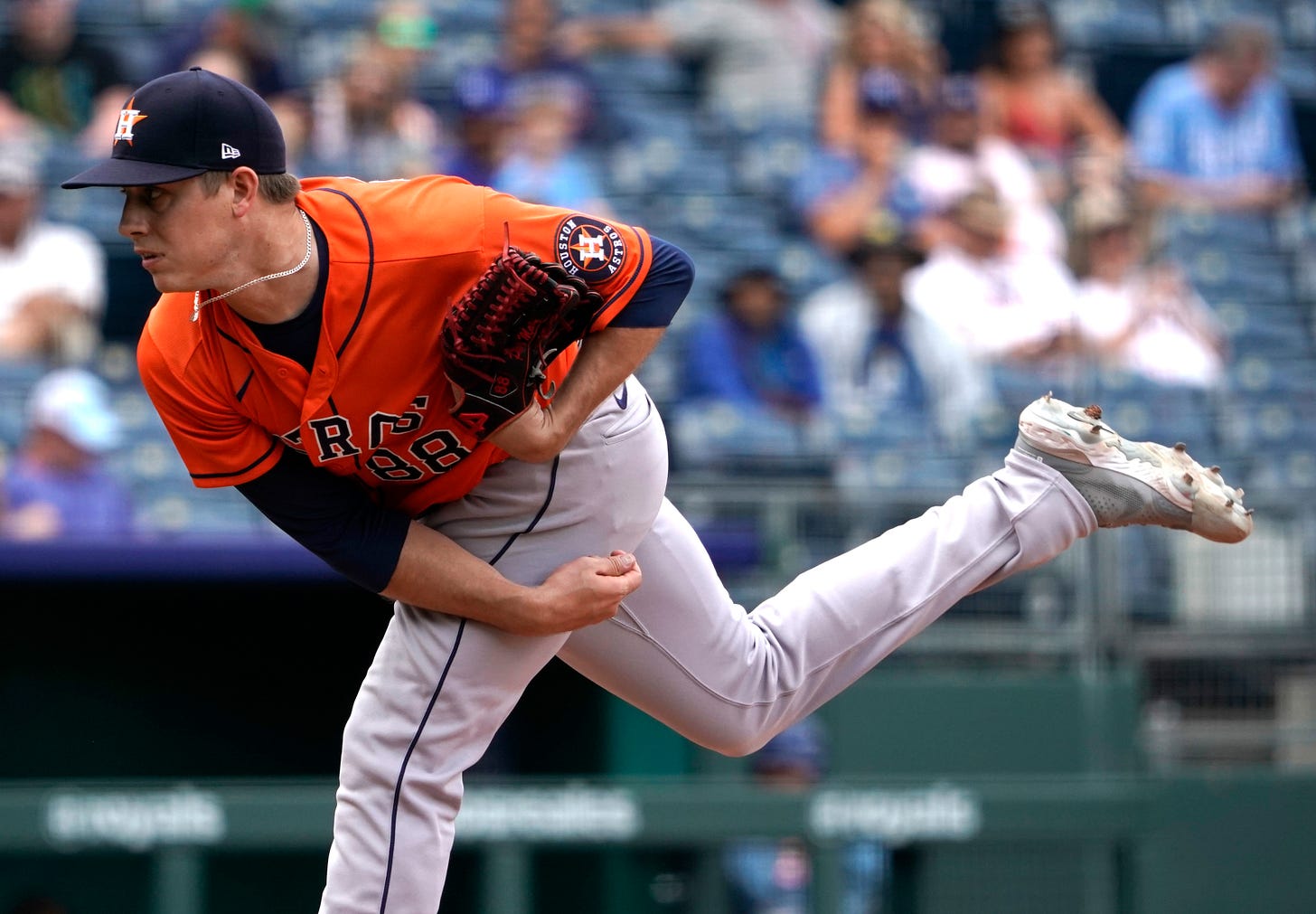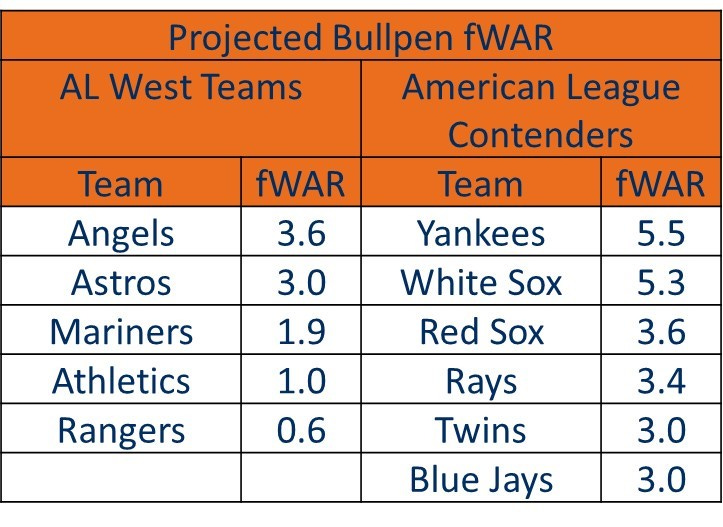Is the Bullpen Good Enough?
The Front Office Has Built the 2022 Bullpen Around Internal Candidates, Even Though It Seemed Like It Needed One More Free Agent Signing.
In 2021, the biggest weakness for the Astros was their bullpen. Issues with the bullpen reared their head at the beginning of the 2021 season, and compelled the front office to focus on the bullpen at the trade deadline. Those trades paid dividends as the three pitchers that General Manager James Click acquired at the deadline—Kendall Graveman, Phil Maton, and Yimi Garcia—all played pivotal roles in winning the American League pennant, especially in the League Championship Series against the Red Sox.
This season, the bullpen again appears to be a work in progress for the Astros. The team lost Graveman and Garcia as free agents to other American League contenders (the White Sox and Blue Jays respectively). They added Hector Neris to the bullpen on a two year contract. The projected bullpen includes holdovers like Maton, closer Ryan Pressly, setup man Ryne Stanek and lefty specialist Blake Taylor. Cristian Javier is expect to start the season in the bullpen, but would move to the rotation if any addition starters need time on the injured list.
In addition, the 2022 bullpen should include two arms who pitched very little in 2021—Pedro Baez and Rafael Montero. Both suffered injuries last season that limited their ability to pitch for the Astros, but both seem in better health this season and should see innings in the April bullpen.

So how good is this bullpen? There is glass half-full and a glass half-empty perspective to that answer. One the one hand, the Astros bullpen is projected as the 11th best in major league baseball using the Depth Charts projections at Fangraphs. That would be better than the 2022 bullpen, which finished 14th in the majors in fWAR. By that standard, the 2022 bullpen would be a slight improvement on the 2021 version. The bullpen is led by closer Ryan Pressly, who is projected as the 6th best reliever in baseball by Depth Charts and is one of only seven relievers projected to have an ERA under 3.00. Pressly’s projected 1.6 fWAR makes up over half of the whole bullpen’s 3.1 projected fWAR.
So that is the glass-half full perspective. The glass half-empty perspective is the best projected bullpens in baseball are concentrated among American League contenders. The chart below shows the projected fWAR for the AL West teams on the left (including the Astros) and American League contenders on the right. American League contenders have the 1st, 2nd, 4th, 7th, 8th, and 9th ranked bullpens entering the season. The Astros are ranked 7th best in the AL.
In order for the Astros bullpen to exceed these projections this season, they need several individual relievers to exceed current expectations. There are couple of bullpen guys who would seem to be key to this potential that are worth highlighting.
Phil Maton—Maton was the long-term trade deadline acquisition for the Astros at the deadline, exchanged for then-starting centerfielder Myles Straw. Maton was a frustrating player during the regular season, with a 4.97 ERA in his 2 months on the Astros roster. But Maton turned the corner in the playoffs, giving up only 1 run in 12.1 post season innings, backed up with a 14-to-3 K/BB ratio. The Astros made changes to Maton’s slider, turning it into a “sweeper.” If the Maton we saw in the 2021 playoffs if the Maton we see in the 2022 season, then the Astros have a key bullpen asset.
Rafael Montero—Remember when the Astros traded Abraham Toro for Kendall Graveman. The trade was bigger than that, as the Astros also sent out Joe Smith and the Mariners included Rafael Montero. While that part of the deal seemed primarily focused on staying under the luxury tax threshold in 2021, the Astros kept Montero this off-season and tendered him an arbitration offer. Montero’s record is modest at best (5.18 career ERA, though his career FIP is better at 4.35). But Montero’s Statcast numbers from 2021 indicate he might be a better pitcher than that. He induced soft contact and seemed to suffer from bad defensive luck. Getting Montero’s actual numbers to meet those Statcast numbers would be quite welcome this season.
Pedro Baez—Baez was the Hector Neris of 2021, in that he was the team’s big off-season bullpen free agent acquisition, coming off of years of being a bullpen mainstay for the Dodgers. Baez spent all but 14 days of the 2021 season on the injured list, and when he did pitch in the majors, his velocity was significantly down when he did pitch. Radar gun readings of Baez in Spring Training show he’s not back to peak velocity, and that has left Cody Poage of The Crawfish Boxes arguing that “the Astros ought to be concerned about Pedro Báez and his continued velocity decline.” It will be hard to count on anything from Baez this season. But he’s likely to make the Opening Day roster and will get a chance to prove his worth in the bullpen.
Should The Front Office Have Signed Another Free Agent Reliever?
The reliance on these three relievers this year highlights two important points about how the 2022 bullpen is constructed. The first is that the front office did not make an addition to the bullpen after the lockout ended. In December, Jake Kaplan of The Athletic reviewed the bullpen and asked if “whether they have enough or if they should pursue another reliever or two after MLB’s lockout ends and free agency resumes.” He thought “another signing could raise the floor of the position group.”
The front office obviously disagreed. There were a number of high quality relievers signed as free agents this off-season who seemed like they could be Astros targets—Collin McHugh, Ryan Tepera, Aaron Loup, Andrew Chafin, Jake Diekman, Daniel Hudson, and Matt Strahm. Yet the front office did not play in that market, relying instead on internal options to build the bridge to Pressly.
The team certainly has the financial capability to sign a reliever, as the payroll is down from the 2021 season (and revenues should be up). The new collective bargaining agreement created $20 million more in space below the luxury tax threshold. This decision seems curious, as the match between need and payroll space seemed clear.
The second point about the construction of the 2022 bullpen is how much it is reliant on players developed by other organizations. Or to put it another way, the Astros have not been able to develop relief pitchers who the organization feels confident in during the playoffs.
This is notable because it is one of the few areas where the franchise has not been able to develop young players, either as stars, regulars, or trade assets. And it is not for a lack of candidates. In recent years, potential bullpen arms like Josh James, Bryan Abreu, and Enoli Paredes have all debuted and showed a good deal of promise. Other bullpen arms like Andre Scrubb, Cionel Perez, Cy Sneed have all debuted to less fanfare, but none have stuck on the major league roster.
This has left the front office to identify veteran relievers in other organizations to acquire via trade or free agency. And that may have had some influence on the decision not to pursue another reliever in free agency. As Kaplan pointed out earlier in Spring Training, the only pitchers the Astros could option to the minors are Stanek, Maton, and Taylor “and all three are pitchers the Astros want to be entrenched on their major-league roster. So, effectively, they project to have seven relievers they can’t option plus an excess starter [Cristian Javier] in their bullpen.” Why is this an issue? As Kaplan argued “having a bullpen full of pitchers who can’t be optioned would present challenges on those inevitable days that a fresh arm is needed from the minors.”
The Astros will get a break on that issue in the month of April as Major League Baseball will expand rosters to 28. This will allow teams to carry more pitchers to deal with the fact that the shortened Spring Training left starting pitchers less time to ramp up to going a full set of innings. But after May 2, they will have to stick with at most 13 pitchers.
And it is of course worth adding the most important caveat with any analysis of bullpens and relievers. They are volatile—both individually and collectively. Because individual relievers pitch in such short samples, it is difficult for them to maintain a consistent performance from year to year. And because the skill difference between relievers are relatively small, the collective performance of a group of relievers can shift in their relative value between teams. It would not take much for the Astros relievers to exceed their projections. But it wouldn’t take much for them to underperform them. And that is true for every team.
The front office believes that this set of relievers can do the job, and that guys like Phil Maton and Rafael Montero have made improvements since 2021 and will perform better this year. They are sticking with Pedro Baez for now, and have guys who have been effective before like Ryne Stanek and Cristian Javier ready to get the ball to Ryan Pressly. While it does seem like a bullpen that could use another guy in it, there are reasons to have faith in the bullpen for the 2022 season. Let’s hope that faith is rewarded.




